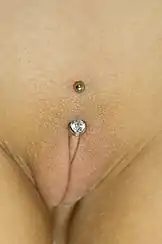Mons pubis
In human anatomy, and in mammals in general, the mons pubis or pubic mound (also known simply as the mons, and known specifically in females as the mons Venus or mons veneris)[1][2] is a rounded mass of fatty tissue found over the pubic symphysis of the pubic bones.[1][2][3][4][5][6]
| Mons pubis | |
|---|---|
 Mons pubis (with pubic hair removed) | |
| Details | |
| Precursor | Genital tubercle |
| Identifiers | |
| Latin | mons pubis |
| TA98 | A09.2.01.002 |
| TA2 | 3548 |
| FMA | 20218 |
| Anatomical terminology | |
Anatomy
For females, the mons pubis forms the anterior portion of the vulva. It divides into the labia majora (literally "larger lips"), on either side of the furrow known as the pudendal cleft, that surrounds the labia minora, clitoris, urethra, vaginal opening, and other structures of the vulval vestibule.[2][5][6]
Although present in both men and women, the mons pubis tends to be larger in women.[1][6] Its fatty tissue is sensitive to estrogen, causing a distinct mound to form with the onset of female puberty.[4][6][7][8] This pushes the forward portion of the labia majora out and away from the pubic bone. The mound also becomes covered with pubic hair. It often becomes less prominent with the decrease in bodily estrogen experienced during menopause.[9]
Etymology
The term mons pubis is derived from Latin for "pubic mound". The more specifically female mons Venus or mons veneris is derived from Latin for "mound of Venus".[1][2]
Society and culture


Although not part of external genitalia itself, the pubic mound can be regarded as an erogenous zone and is highly eroticized in many cultures. Throughout history, the complete or partial removal of pubic hair has been common in many societies, and more recently it has become widespread in the Western world. The full removal of pubic hair by use of wax, sugar or shaving, known as ″Brazilian wax″, has become common practice in recent years.[10][11][12]
In some circumstances, the mons veneris is subjected to aesthetic ideals beyond hair removal. Correspondingly, plastic surgery is offered which alters the shape of the mons to a desired ideal.[13] Desired ideals may be influenced by personal preferences, current cultural norms, or societal pressures.
Permanent forms of decoration to enhance the aesthetic appeal of this area are hanabira, the application of cosmetic scars,[14] or piercings such as the Christina piercing or the Nefertiti piercing.[15] Vajazzling refers to the non-permanent decoration of the mons pubis with crystal ornaments.[16][17]
Bibliography
- Sloane, Ethel. Biology of Women. Cengage Learning 2002, ISBN 978-0-7668-1142-3, p. 31
- Gray, Henry: Anatomy of the Human Body. Lea & Febiger, 1918
- "Mons pubis" in Encyclopædia Britannica Online. 2010.
References
- New Oxford American Dictionary. Oxford University Press. 2011.
The rounded mass of fatty tissue lying over the joint of the pubic bones, in women typically more prominent and also called the mons veneris.
- Gould, A.M.; George Milbry, M.D (1894). An Illustrated Dictionary of Medicine, Biology and Allied Sciences. Philadelphia: P. Blakiston, Son & Company. pp. 778–779. Retrieved 2014-10-08.
Mons pubis: the eminence in front of the body and horizontal ramus of the os pubis; it is called also, in the female, mons veneris.
- "mons pubis". Merriam–Webster. Retrieved 2013-09-18.
A rounded eminence of fatty tissue on the pubic symphysis especially of the human female.
- "mons pubis". American Heritage Dictionary. 2011. Retrieved 2013-09-19.
A rounded fleshy protuberance situated over the pubic bones that becomes covered with hair during puberty.
- Zink, Christoph (1988). Dictionary of Obstetrics and Gynecology. Berlin: Walter de Gruyter & Co. p. 201. ISBN 3110857278. Retrieved 2014-10-08.
Pubic mount: mons pubis, in females mons veneris; the hairy region above the anterior commissure of the large labia or penis.
- Basavanthappa, B.T. (2006). Textbook of Midwifery and Reproductive Health Nursing (1st ed.). New Delhi: Jaypee Brothers Medical Publishers. pp. 23, 42, 791. ISBN 8180617998. Retrieved 2014-10-08.
[Female] mons pubis (mons veneris), labia majora and minora, clitoris, prepuce of clitoris, vestibule, fourchette, and perineum… [Male] mons pubis, penis, and scrotum… Hair-covered fat pad overlying the symphysis pubis.
- Gray, Henry (1918). Lewis, Warren H. (ed.). Anatomy of the Human Body (20th ed.). Philadelphia: Lea & Febiger. ISBN 1-58734-102-6.
- Myers, J.D., John E.B. (2011). The APSAC Handbook on Child Maltreatment (3rd ed.). Thousand Oaks, California: SAGE Publications. ISBN 978-1412966818. Retrieved 2014-10-08.
- Braun, Kirsten (2007-09-01). "Ageing down under". Women's Health, Queensland Wide. Archived from the original on 2014-10-15. Retrieved 2014-10-08.
- Stone, N., Graham, C. A., & Baysal, I. (2017). Women's Engagement in Pubic Hair Removal: Motivations and Associated Factors. International Journal of Sexual Health, 29(1), 89-96.
- Lidola, M. (2014). Negotiating integration in Berlin’s waxing studios: Brazilian migrants’ gendered appropriation of urban consumer spaces and ‘ethnic’entrepreneurship. Journal of Contemporary History, 49(1), 228-251.
- Herbenick, D., Schick, V., Reece, M., Sanders, S., & Fortenberry, J. D. (2010). Pubic hair removal among women in the United States: Prevalence, methods, and characteristics. The Journal of Sexual Medicine, 7(10), 3322-3330.
- Triana, L., & Robledo, A. M. (2015). Aesthetic surgery of female external genitalia. Aesthetic surgery journal, 35(2), 165-177.
- Schnittiger Trend? Scarification statt Tattoo - Stylight
- Van der Meer, G. T., Schultz, W. W., & Nijman, J. M. (2008). Intimate body piercings in women. Journal of Psychosomatic Obstetrics & Gynecology, 29(4), 235-239.
- Turney, J. (2016). Vajazzled!!! Pursuits for the hirsute. Clothing Cultures, 3(2), 143-153.
- 7 Things You Didn't Know About Vajazzling - Cosmopolitan
External links
 Media related to Mons pubis at Wikimedia Commons
Media related to Mons pubis at Wikimedia Commons- Anatomy photo:41:02-0102 at the SUNY Downstate Medical Center – "The Female Perineum: The Vulva"
